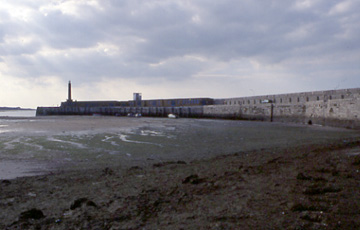
Back to Introduction
Display Contents
Industrial Furniture
Travelling Crane Track
Mooring Posts
Rope Marks
Engraved Coping Stones
Pier Furniture
Mooring Rings
Timber Settings
Railing Scars
Lamp Post Scars
The Pier Structure
Historic Images
1953 Storm Damage

Industrial Furniture
Travelling Crane Track
A metal rail is visible on the present pier and runs the length of Sections 3, 4 and 5 finishing eight metres short of the pier end. This rail represents one of the rails used by a number of travelling cranes operating on Sections 3 – 5 of the pier. The travelling cranes were wheeled moving along tracks and used for the loading and unloading of cargo on the pier including coal coming into Margate and coke being shipped out by the South Eastern Gas Board from their King Street depot. Early photographs show more than one crane operating on the pier at a time; some fixed to the pier, others are shown as travelling cranes. No identifiable evidence for the fixed cranes remain on the pier.
Travelling Crane Track
A metal rail is visible on the present pier and runs the length of Sections 3, 4 and 5 finishing eight metres short of the pier end. This rail represents one of the rails used by a number of travelling cranes operating on Sections 3 – 5 of the pier. The travelling cranes were wheeled moving along tracks and used for the loading and unloading of cargo on the pier including coal coming into Margate and coke being shipped out by the South Eastern Gas Board from their King Street depot. Early photographs show more than one crane operating on the pier at a time; some fixed to the pier, others are shown as travelling cranes. No identifiable evidence for the fixed cranes remain on the pier.

Mooring posts styled to look like cannon barrels exist on Section 4 of the pier. These posts are not original as their location first appears on the 1907 map of the pier.


A number of etched or engraved markings on the inner faces of upper coping stones are visible along the harbour. The engraved stones are visible from the pier structure rather than the Harbour. Three engraved stones were recorded “W”, “CB 4” and “CB 9” These markings probably relate to mooring rights or to loading positions of ships or cranes. The “CB” may stand for Coal Board.

Mooring rings
Various elements of mooring furniture are visible along the inner harbour wall. These consist of large iron rings fixed into stone blocks. Two types are represented, one a single welded Iron ring held in the loop at the end of an Iron pin. The second a ring with double looped ends that were joined to a looped pin with a central cotter pin.

Vertical squared timber beams have been used since the pier was first constructed to protect the stone harbour structure from damage from the movement of moored craft. In recent times some of the vertical timber structures have been removed.
Timber beams are visible on early engravings and photographs of the pier associated with mooring points for ships. In places the stone used to construct the pier has been chased to provide a recess for the beams. The locations of missing timber uprights are clearly visible from the harbour basin at low tide.

The use of railings for safety
purposes in the original construction of the pier is evident along the
promenade deck and in front of the Droit Office along the inner harbour
wall.

Railings
along the promenade and at the edge of the stone steps are shown in
photographs and engravings from the early 1800’s onwards. The original
railings sat on a low stone plinth, a scar where the stone plinth has
been removed is clearly visible.


An engraving from 1851 shows lamp columns visible on the top of the outer harbour wall from Section 3 of the pier onwards. An engraving from 1895 shows lamps added along the full length of outer harbour wall along the promenade. Only the metal collars where the posts supporting the lamps were set into the stone blocks of the outer harbour wall now survive.

Clements, R. Whyman, J. & Perkins, D. R. J. Britain in Old Photographs. Thanet. Alan Sutton
Scurrell, D. 1982. The Book of Margate. Barracuda Books Ltd.
White, A. 2004 A History of Whitby.
Emma
Boast
Version 1. Posted 27.02.06
Version 1. Posted 27.02.06
All
content © Trust for Thanet Archaeology
